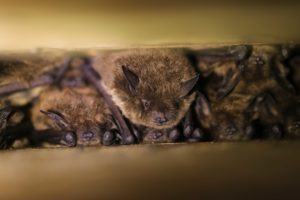It’s true – bats have a bad rap.
They’re best buddies with Dracula and have a cameo in “Macbeth.” They inspire spooky Halloween decorations.
But then there’s Batman. And those of us who know bats – like here at Northwest Trek – know that they truly are the superheroes of the night: zipping effortlessly in the dark using echolocation or cutting-edge wing design, munching their own weight in mosquitoes every night or spreading fruit seeds, and pollinating the world’s plants as they go.
Right off the bat, without batting an eyelid, we’re going to bat for these adorable furry creatures – and this Halloween, we want you to meet ours.
Meet the Northwest Trek bats

They don’t have names – there are just too many of them! Northwest Trek is home to one of the largest wild bat colonies in the South Puget Sound region: They roost under the eaves of our tram garage, our veterinary clinic, our administration building and around the park, including in all the bat boxes we’ve put on trees.
Yuma myotis, little brown myotis, California myotis, silver-haired and hoary bats, they chitter and squeak as they wake up each sunset to fly out into the forest. We love them, not just because they’re tiny, fuzzy and cute (although they are!) but because they keep us all healthy: Pacific Northwest bats are insectivores, consuming their own body-weight in bugs every night. If we didn’t have bats, we would get eaten alive by mosquitoes – and farmers would have a much harder time growing our food.

Other American bats also pollinate plants as they fly around. If you drink tequila or admire saguaro, you can thank a bat: They are the key pollinators of agave and cactus plants.
Their other superpower is echolocation, the ability to navigate purely via sound. As bats fly, they emit high-pitched sounds (beyond human detection) which bounce off surrounding objects and return to their ears. Bat echolocation is so sensitive that a bat flying 25 miles per hour in complete darkness could distinguish a junebug from the leaf it sits on. Even Batman couldn’t beat that.
Our wild bats also help science. We count and study them to look for white-nose syndrome, a devastating fungal disease that affects hibernating bats but does not pose a threat to humans or other wildlife.
“Bats are astounding animals who pollinate our food and control insects which would otherwise invade us,” says Rachael Mueller, who leads annual bat counts at Northwest Trek. “And everyone can help protect them. Improve bat habitat around your home by reducing outside lighting and protecting trees, streams and wetlands. And protect them from disease by staying away from their roosting sites. We need bats, and like all wildlife we can live in harmony with them if we give them space.”
The bottom line? Bats ARE superheroes of the night – and we can save them. There’s not a moment to lose.
Learn more about what Northwest Trek is doing to save wild bats here.